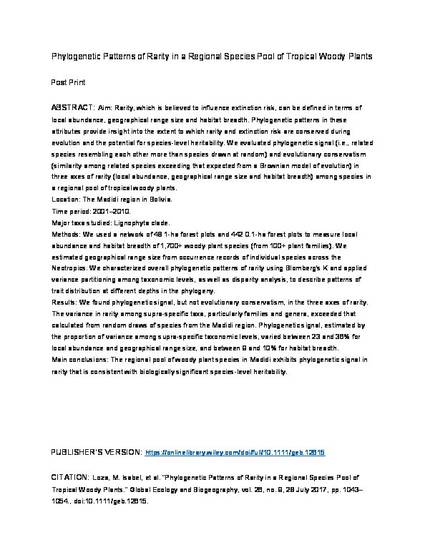
Article
Phylogenetic Patterns of Rarity in a Regional Species Pool of Tropical Woody Plants
Global Ecology and Biogeography
(2017)
Abstract
Aim
Rarity, which is believed to influence extinction risk, can be defined in terms of local abundance, geographical range size and habitat breadth. Phylogenetic patterns in these attributes provide insight into the extent to which rarity and extinction risk are conserved during evolution and the potential for species‐level heritability. We evaluated phylogenetic signal (i.e., related species resembling each other more than species drawn at random) and evolutionary conservatism (similarity among related species exceeding that expected from a Brownian model of evolution) in three axes of rarity (local abundance, geographical range size and habitat breadth) among species in a regional pool of tropical woody plants.
Location
The Madidi region in Bolivia.
Time period
2001–2010.
Major taxa studied
Lignophyta clade.
Methods
We used a network of 48 1‐ha forest plots and 442 0.1‐ha forest plots to measure local abundance and habitat breadth of 1,700+ woody plant species (from 100+ plant families). We estimated geographical range size from occurrence records of individual species across the Neotropics. We characterized overall phylogenetic patterns of rarity using Blomberg's K and applied variance partitioning among taxonomic levels, as well as disparity analysis, to describe patterns of trait distribution at different depths in the phylogeny.
Results
We found phylogenetic signal, but not evolutionary conservatism, in the three axes of rarity. The variance in rarity among supra‐specific taxa, particularly families and genera, exceeded that calculated from random draws of species from the Madidi region. Phylogenetic signal, estimated by the proportion of variance among supra‐specific taxonomic levels, varied between 23 and 36% for local abundance and geographical range size, and between 9 and 10% for habitat breadth.
Main conclusions
The regional pool of woody plant species in Madidi exhibits phylogenetic signal in rarity that is consistent with biologically significant species‐level heritability.
Disciplines
- Biology and
- Paleontology
Publication Date
January 9, 2017
DOI
10.1111/geb.12615
Citation Information
M. Isabel Loza, Iván Jiménez, Peter M. Jørgensen, Gabriel Arellano, et al.. "Phylogenetic Patterns of Rarity in a Regional Species Pool of Tropical Woody Plants" Global Ecology and Biogeography Vol. 26 Iss. 9 (2017) p. 1043 - 1054 Available at: http://works.bepress.com/robert-ricklefs/7/
